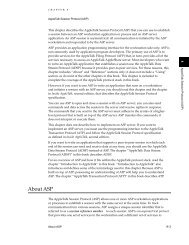URL Loading System Programming Guide - Apple Developer
URL Loading System Programming Guide - Apple Developer
URL Loading System Programming Guide - Apple Developer
Create successful ePaper yourself
Turn your PDF publications into a flip-book with our unique Google optimized e-Paper software.
Authentication Challenges and TLS Chain Validation<br />
Responding to an Authentication Challenge<br />
<strong>URL</strong>Session:didReceiveChallenge:completionHandler:<br />
<strong>URL</strong>Session:task:didReceiveChallenge:completionHandler:<br />
connection:didReceiveAuthenticationChallenge:<br />
download:didReceiveAuthenticationChallenge:<br />
In order for the connection to continue, the delegate has three options:<br />
●<br />
●<br />
●<br />
Provide authentication credentials.<br />
Attempt to continue without credentials.<br />
Cancel the authentication challenge.<br />
To help determine the correct course of action, the NS<strong>URL</strong>AuthenticationChallenge instance passed to<br />
the method contains information about what triggered the authentication challenge, how many attempts<br />
were made for the challenge, any previously attempted credentials, the NS<strong>URL</strong>ProtectionSpace that requires<br />
the credentials, and the sender of the challenge.<br />
If the authentication challenge has tried to authenticate previously and failed (for example, if the user changed<br />
his or her password on the server), you can obtain the attempted credentials by calling proposedCredential<br />
on the authentication challenge. The delegate can then use these credentials to populate a dialog that it<br />
presents to the user.<br />
Calling previousFailureCount on the authentication challenge returns the total number of previous<br />
authentication attempts, including those from different authentication protocols. The delegate can provide<br />
this information to the user, to determine whether the credentials it supplied previously are failing, or to limit<br />
the maximum number of authentication attempts.<br />
Responding to an Authentication Challenge<br />
The following are the three ways you can respond to the<br />
connection:didReceiveAuthenticationChallenge: delegate method.<br />
Providing Credentials<br />
To attempt to authenticate, the application should create an NS<strong>URL</strong>Credential object with authentication<br />
information of the form expected by the server. You can determine the server’s authentication method by<br />
calling authenticationMethod on the protection space of the provided authentication challenge. Some<br />
authentication methods supported by NS<strong>URL</strong>Credential are:<br />
2013-10-22 | Copyright © 2003, 2013 <strong>Apple</strong> Inc. All Rights Reserved.<br />
54
















